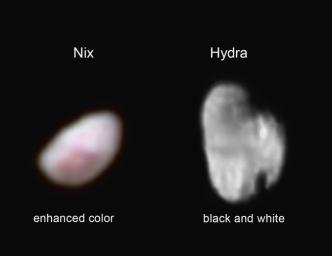
|
‘Capturing’ Nix and Hydra
- Click the image above for a larger view
- Full-Res JPEG (1401 x 1080) (48.2 kB)
- Full-Res TIFF (1401 x 1080) (4.5 MB)
Caption:
Pluto's moon Nix (left), shown here in enhanced color as imaged by NASA's New Horizons Ralph instrument, has a reddish spot that has attracted the interest of mission scientists. The data were obtained on the morning of July 14, 2015, and received on the ground on July 18. At the time the observations were taken New Horizons was about 102,000 miles (165,000 km) from Nix. The image shows features as small as approximately 2 miles (3 kilometers) across on Nix, which is estimated to be 26 miles (42 kilometers) long and 22 miles (36 kilometers) wide.
Pluto's small, irregularly shaped moon Hydra (right) is revealed in this black and white image taken from New Horizons' LORRI instrument on July 14, 2015 from a distance of about 143,000 miles (231,000 kilometers). Features as small as 0.7 miles (1.2 kilometers) are visible on Hydra, which measures 34 miles (55 kilometers) in length.
Background Info:
The Johns Hopkins University Applied Physics Laboratory in Laurel, Maryland, designed, built, and operates the New Horizons spacecraft, and manages the mission for NASA's Science Mission Directorate. The Southwest Research Institute, based in San Antonio, leads the science team, payload operations and encounter science planning. New Horizons is part of the New Frontiers Program managed by NASA's Marshall Space Flight Center in Huntsville, Alabama.
Cataloging Keywords:
| Name | Value | Additional Values |
|---|---|---|
| Target | Pluto | Hydra, Nix |
| System | Pluto | Kuiper Belt |
| Target Type | Satellite | Dwarf Planet, KBO |
| Mission | New Horizons | |
| Instrument Host | New Horizons | |
| Host Type | Flyby Spacecraft | |
| Instrument | Long Range Reconnaissance Imager (LORRI) | Visible/Infrared Imager (RALPH) |
| Detector | ||
| Extra Keywords | Color, Visual | |
| Acquisition Date | ||
| Release Date | 2015-07-21 | |
| Date in Caption | 2015-07-14 | |
| Image Credit | NASA/Johns Hopkins University Applied Physics Laboratory/Southwest Research Institute | |
| Source | photojournal.jpl.nasa.gov/catalog/PIA19847 | |
| Identifier | PIA19847 | |
